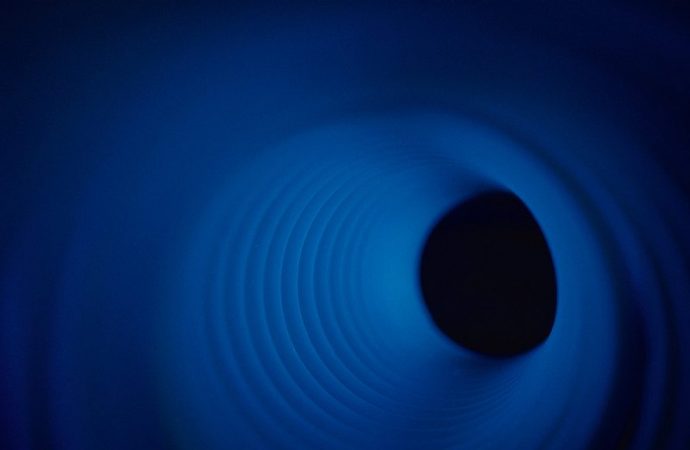“Black holes are important not just for understanding black holes. They are important for studying new physics,”

Ami Jablonovsky/Getty
There’s only one way to study a black hole up close: build a copy in the lab. One physicist claims his desktop black hole, which swallows sound instead of light, has been spotted emitting entangled quantum particles. It could be a breakthrough in studying the exotic physics of these weird objects – although not everyone is convinced this fake black hole is the real deal.
Black holes are the ultra-dense leftovers of dead stars and are black because their gravity is so intense that nothing, including light, can escape from their gaping maws – a point of no return called the event horizon. But a strange quirk of quantum theory suggests black holes aren’t completely dark.
In 1974, Stephen Hawking predicted event horizons should leak a faint glow. Quantum theory says particles all have an antimatter counterpart, and these pairs constantly spring into existence before embracing in mutual oblivion. But a black hole might pull pairs that form at its edge apart: if one of the pair is just outside its clutches, it could escape while the other is pulled across the event horizon. The escaped particle can be seen, in theory, as Hawking radiation.
But this signal is too faint to see from real black holes, so to test it, physicists have built miniature artificial versions in which sound plays the role of light.
Bill Unruh at the University of British Columbia in Canada was one of the first to propose building these black hole-like particle traps. His calculations in 1981 showed these would also emit radiation from their event horizons, analogous to Hawking radiation.
Now, Jeff Steinhauer at the Technion-Israel Institute of Technology in Haifa claims he has seen Hawking radiation arising from quantum entangled particles at the event horizon of his sonic black hole. This entanglement is a key part of Hawking’s theory, and physicists are still debating its consequences in real black holes.

Nitzan Zohar, Technion Spokesperson’s Office
Steinhauer created a sonic black hole using a quantum state of supercold fluid called a Bose-Einstein condensate. The fluid flows through a tube in which lasers constrain the flow at two different energy levels, creating a kind of waterfall. Atoms reach supersonic speeds when they spill over its edge. This serves as the model event horizon.
To measure spontaneous Hawking radiation, he measured pairs of sound particles known as a phonons, that pop into existence near the horizon – just as Hawking suggested happens near a real black hole. He then took pictures measuring the refractive index in the fluid – a method used to image waves – to track the sound particle and its partner particle as they moved toward the event horizon. He repeated the experiment 4600 times over six days.
When he looked through the images, he noticed a dark band emanating in both directions from the event horizon, which he says is evidence that two distinct particles were propagating at the exact same time despite being separated by the horizon. This coincidence suggests the swallowed particles are quantum entangled with free ones, a tell-tale sign of Hawking radiation, says Steinhauer.
“This work verifies Hawking’s calculation, and that it applies to the astrophysical case as well as the analogue case,” he says.
Others complimented his work, but were not quite convinced.
Key quantum feature
Daniele Faccio at Heriot-Watt University in Edinburgh, UK, built an earlier fibre-optic black hole model. He says demonstrating entanglement is the most difficult part of the experiment, but proving it requires making several assumptions about the data, which he says need further testing.
“But if true, then yes, entanglement is a key quantum feature of Hawking emission,” he says.
Unruh echoed his call for independent confirmation. “Big results needs solid proof,” he says. “In any case, I regard this as a very beautiful experiment, one that people have thought of doing for 10 years now, but he is the first to do so. That he has seen the correlations of emissions by the horizon, whether entangled or not, is a real coup.”
There are a few caveats. The sonic black hole uses sound rather than light, so the flow of particles in the experiment are quite different from the flow at the edge of a real black hole, where gravity warps space-time.
“I don’t think anyone can make claims regarding the existence of this emission in astrophysics,” says Faccio. But given we can’t visit a real black hole, these desktop models are the best alternative. “With so many unknowns and no experiments, these analogues should and must be developed,” he says.
Steinhauer now plans to study how the radiation changes over time. He hopes the modelling effort sheds light on the strange physics of some of the most exotic objects in the cosmos.
“Black holes are important not just for understanding black holes. They are important for studying new physics,” he says.
Journal reference: Nature Physics, DOI: 10.1038/nphys3863
Article amended on 16 August 2016
The details of the experiment have been clarified
Source: New Scientist

































Leave a Comment
You must be logged in to post a comment.